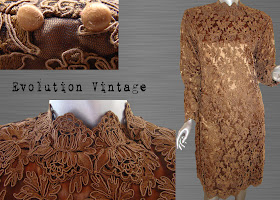 Vintage Balenciaga Lace Hat
Vintage Balenciaga Lace HatI Love LACE! It is a style element that can reflect two sides of the fashion coin; it can make a look soft and feminine or give it Edge and Rock'n'Roll. Lace is all over the place, but has a very Rich history. The concept originated with the Pharaohs using flax cloth decorated with colored threads working them into their own geometric designs.
 Balenciaga 1950's lace dress
Balenciaga 1950's lace dressThe site ERAS OF ELEGANCE gives a fabulous and concise history of lace, how it was created and used in FASHION! "The ancient Greeks and Romans also ornamented their togas with colors or gold. A new garment needed no ornament about the immediate edge, but as it became worn and frayed, the threads had to be twisted and stitched together. Lace was derived from the twisting techniques used in decoration of the fringe ends of woven fabric.
True lace was not made until the late 15th and early 16th centuries. In Flanders, lace is called "kant", meaning border or edge. The birthplaces of lacemaking are generally recognized as Flanders and Italy. A true lace is created when a thread is looped, twisted or braided to others threads independently from a backing fabric. Originally linen, silk, gold, or silver threads were used. Now lace is often made with cotton thread. Manufactured lace may be made of synthetic fiber. A few modern artists makes lace with a fine copper or silver wire instead of thread.
For firm evidence of the origins of lace, written history indicates that Charles V decreed that lace making was to be taught in the schools and convents of the Belgian provinces. During this period of renaissance and enlightenment, the making of lace was firmly based within the domain of fashion. To be precise, it was designed to replace embroidery in a manner that could with ease transform dresses to follow different styles of fashion. Unlike embroidery, lace could be unsewn from one material to be replaced on another. Lace became fashionable on collars and cuffs for both sexes. Trade reached a peak in the 18th century.
Additionally, the vogue for lace also is recorded in pattern books as early as 1540. Early reticella designs usually included pointed or scalloped edges. By the time of Charles I, lace was used extravagantly for both costume and interior decorating; by 1643, lace making had become an established industry. In France patterns became increasingly more detailed and delicate; the light, flowery point de France was used for every conceivable decorative purpose. Later the laces of Alencon, Argentan, and Valencienne exemplified French style and design. The making of bobbin, pillow, or bone lace, which is mentioned as early as 1495, passed from Italy to Flanders, reaching its height of production there in the 18th century.
Machine-made lace first appeared circa 1760, and by 1813, a bobbinet machine was perfected. After 1832, cotton thread somewhat replaced linen. In the 20th century, many lace patterns have been revived and modified, and called Cluny lace. The chief modern centers of lace making are France, Belgium, England, Ireland, and Italy."
Lace looks have spanned all era's
 Madonna has ALWAYS been a LACEY LASS!
Madonna has ALWAYS been a LACEY LASS!Lace is still relevant on the red carpet and runways today. Black is the basic and most classic but colored lace has made a chic comeback.




There are too many "Types" of lace to list so if you are interested you can explore via the LACE FAIRY IDENTIFICATION PAGE
Get LACED From your FACE
 Carol Alt - 80's lace veil
Carol Alt - 80's lace veilto your FEET
 DIOR
DIORCan you EMBRACE the LACE? SHOP EVOLUTION VINTAGE








Want to go BOHO? Check out this Vintage 70's beauty from 4BirdsVintage
 "Lace - the invention of a goddess and the occupation of a queen" - Vincio
"Lace - the invention of a goddess and the occupation of a queen" - Vincio 
Persnikety Vintage has the BLUES
I have an irrational dislike of actual flesh or beige coloured fabric under lace (think Madonna looks shocking in the first image). However I absolutely love the 80s blusher veil and Scarlet Johansson's green dress.
ReplyDelete